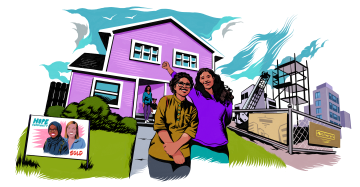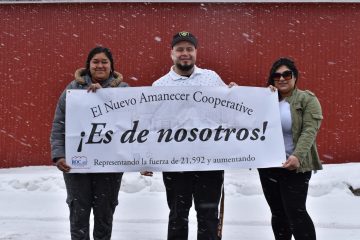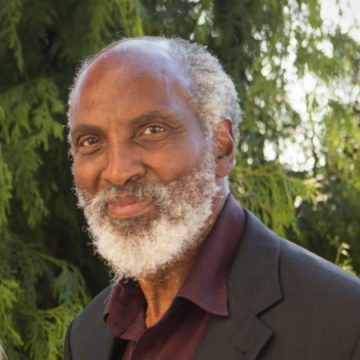Story
To Live in Hope
Hope Community’s innovative path to homeownership creates new opportunities for building wealth and inspires community partners to think big
DATE
November 12, 2021

By Sarah Chandler
Bianca Franks grew up on Minneapolis’ North side in a family where her single mother struggled to support four children. Owning their own home didn’t seem possible.
“I was a Cookie Cart kid,” Franks fondly recalls, referencing the organization that offers teens the chance to learn leadership and work skills while baking fresh snickerdoodles and ginger snaps in a neighborhood bakery. Franks and her siblings never understood the path to homeownership, because that distant dream was something “you don’t recognize, and no one around you recognizes,” she says.
But that has changed thanks to Hope Community, a nonprofit community center serving the Phillips neighborhood in Minneapolis. In 2019, aided by a $207,000 Community Innovation grant from the Bush Foundation, Hope Community launched a home-ownership pilot program that seems radical in its simplicity: Help first-time home buyers become not only homeowners, but also landlords who, in turn, support the local community and build wealth for their families.
The pilot program is providing a quietly revolutionary response to the neighborhood’s historic challenge to preserve local ownership. It provides a growing community of affordable, owner-occupied duplexes for residents who, like Franks and her family, have historically been marginalized by financial capacity, stagnant wages and lack of affordable housing.
And the impact is spreading. Hope Community’s homeownership pilot has inspired other community partners, such as Family Housing Fund, to invest in owner-occupant multifamily housing across the Twin Cities metro region. In turn, the Bush Foundation has awarded Hope an unrestricted grant of $100,000 to honor their role as innovator.
“We want to honor Hope Community’s leadership role in developing this idea and make certain they receive financial benefits from its spread,” explains Jen Ford Reedy, president of the Bush Foundation.
A Cultural Nexus
With lively paintings by local American Indian artists at the All My Relations Arts gallery and stacks of savory corn pancakes dusted with cotija cheese at Maria’s Cafe, it’s obvious the Phillips neighborhood is one of Minneapolis’ most vibrant communities, pulsing with commerce and culture. Arguably the most diverse neighborhood in the state, Phillips has long been a vanguard of progressive politics — as well as a nerve center of social tumult.
“Historically, it has been a landing place for new arrivals, with a vortex of jobs, access to downtown and valued connections,” reflects Will Delaney, associate director of Hope Community.
First settled in 1856 by European immigrants and Black families leaving the South, Phillips became a bustling multiethnic urban village by the turn of the 20th century. Workers flocked here to take part in the burgeoning industries of the era: lumber, railroads and flour milling. Opulent Queen Anne, Romanesque and Greek Revival mansions lined the grand thoroughfares of Portland and Park avenues, housing the city’s founding industrialists.
Yet by the early 1990s — a time when Minneapolis made headlines as often for murder rates as it did for Twins wins — hundreds of dilapidated and boarded-up homes, including dozens of architectural gems, lent the neighborhood an air of abandonment. As drug crime and poverty rose, urban renewal “solutions” often meant bulldozing working class and poor neighborhoods to make way for freeways. These tactics were less about revitalizing communities and more about wiping the slate clean.
Shannon Smith Jones, executive director of Hope Community, explains that this type of gentrification means “Our stories get erased. Our contributions get erased.”
Around that time, Hope Community — first established in 1977 as a homeless shelter for women and children — transformed its mission with an ambitious focus on housing justice and equitable urban development. Slowly, Hope began buying up neighborhood properties at rock-bottom prices to rehabilitate and rent to low-income residents at affordable rates.
Radical Listening
After its switch to its new mission, Hope Community staff began to engage with neighborhood residents through community listening sessions. This practice presented an opportunity to hear “what residents thought of the neighborhood, what their dreams and visions were,” Delaney explains. (Hope Community also received a 2015 Bush Prize in recognition of its track record of finding innovative solutions to community challenges, fueled by its model of continuous community engagement.)
While community members disliked the negative aspects of the city, they believed that their neighborhood would improve — just not for them. Luxury condos were popping up in the corridors leading to downtown, but wage growth was static. Housing options in the gentrifying neighborhood were out of reach for existing residents.
These conversations became the catalyst for Hope to think outside the binary choice to gentrify or not. “We asked ‘What does an alternative to gentrification look like?’” Delaney recalls.
In the years since their first community listening sessions, Hope Community’s affordable housing work has grown beyond purchasing and rehabbing neighborhood buildings. They now also work with land banks like the City of Lakes Community Land Trust to purchase land in a proactive strategy to counteract increasing property values. When a land trust takes a property off the market, it’s no longer subject to rising prices, and can be held until new owners are ready to build or purchase a home. Keeping ownership within the community, says Bush Foundation grantmaking officer Rudy Guglielmo, “supports a preserving housing strategy.” Ultimately, land trusts aim to create affordable housing that also builds wealth.
Today, 750 people live in rental apartments that Hope owns and maintains in partnership with Aeon, a property management firm. Seventy percent are deemed affordable while the remainder are middle-income. Hope also holds 50 additional rental units and four townhomes offering affordable home ownership to residents. Some Hope residents, like Franks, are making the leap from renter to owner and landlord by taking part in the pilot homeownership program.
“I think of social capital when I think of homeownership,” Smith Jones says. “Homeowners can be anchors.”
Beyond Single-Family Homes
Hope Community’s pilot program aside, homeownership programs tend to focus on single-family homes. And because property management firms specializing in low-income housing tend to work with larger apartment buildings, those who want to rent or buy affordable duplexes or triplexes are often left without a springboard to make the jump.
But Delaney recalls that Hope staff began wondering, “What would homeownership look like in two-, three- or four-family buildings? What would it look like to build this kind of ecosystem?”
A duplex or triplex can offer a solution for people like Franks, whose children have disabilities. The program’s focus on small multifamily units is particularly appealing given the high overhead cost of a single-family home. She envisions owning a building with separate units for her daughter, 23, and son, 18, who is on the autism spectrum, as well as the live-in personal care assistant essential to his independence.
Homeownership as a Business
On a spring day in 2020, Hope Community staff members Malyun Yahye and Maggy Otte were about to begin door knocking around Phillips to recruit residents for the pilot program when the city went on lockdown due to COVID-19. They swiftly regrouped and went online, using social media and word-of-mouth tactics to recruit through nonprofit channels and Hope residents’ rich social networks.
Pilot program participants go through Hope’s six-week renter-to-owner training program, which covers the essentials that homeowners and landlords need to successfully buy, live in, maintain and responsibly rent property to tenants. In conversations over Zoom, participants discuss the thorny subject of improving credit scores (the program requires a credit score of 640) and the complex challenges of maintaining property and being a proactive landlord. After group classes end, one-to-one training is offered.
“The idea is that in three months we’ll check in,” explains Yahye, who co-facilitates training. “We meet them where they are.”
Before participating in Hope Community’s homeownership training classes, Franks admits she had “probably glorified the realities of being a landlord.” The program’s six-part structure, which covers everything from devising a business plan to understanding the complex forces of credit, equity and fluctuating home values, helps participants sort fact from the kind of homeowner fantasies that Franks describes as “fueled by the American Dream.”
“I didn’t look at homeownership as a business like I do now,” Franks says. “And when you grow up in poverty, you don’t learn about credit.”
Onward and Upward
Ultimately, Hope Community’s groundbreaking pilot demonstrates how community-driven innovation can inspire far-reaching impacts. In 2020, Minneapolis nonprofit Family Housing Fund was granted $4 million by the JP Morgan Chase AdvancingCities Challenge to scale up the homeownership project across the metro area. That’s paired with a $4 million Community Innovation grant from the Bush Foundation, part of its $50 million campaign to address racial wealth gaps across the region.
“All across our region, leaders are looking for solutions to transform homeownership,” Guglielmo says. “This owner-occupant landlord model provides a pathway to ownership that can be replicated and advance a community’s vision to preserve affordable housing, foster vibrant neighborhoods and create wealth for its families.”
With a focus on diverse neighborhoods with low rates of homeownership, Family Housing Fund is now expanding on the initial pilot to help first-time homebuyers build community wealth as owner-occupant landlords of small multifamily buildings. In October 2021, the first two duplex purchases successfully went through, both sold to women of color who will become owner-occupant landlords in Minneapolis. “Our goal is really to scale up the people-centered work that Hope is already doing,” says Sarah Berke, program officer at Family Housing Fund.
Despite the fact that most two-, three- and four-family buildings were originally built for owner-occupants, only 40% of small multifamily buildings currently have live-in landlords. Yet, Berke says, encouraging owner-occupants remains one of the best strategies for building strong neighborhoods, given that landlords who live onsite tend to care deeply about what goes on — both in their buildings and on their streets.
Fortunately, the advantages to owner-occupant housing are also financial. When you buy a two- to four-unit property, you can qualify for the same level of mortgage of a single-family home. This becomes a solid wealth-building opportunity given that, as Berke estimates, “You can expect that your own household wealth will increase by at least about $300,000 in 15 years.”
For now, Berke reports, Family Housing Fund hopes to serve about 200 households across the seven-county metro area in the next two years. “And we hope to have impact beyond that,” she adds.
On a neighborhood level, Hope Community is also looking to the future, envisioning a collaboration with the Section 8 program to help participants make the leap to becoming homeowners. Also in the works: acquiring a larger portfolio of land to expand homeownership opportunities in the Phillips neighborhood.
“Hope Community’s work is a shining example of community-driven innovation,” says Guglielmo. “By engaging with their neighbors, thinking outside of the box and piloting a creative idea, they’re improving lives not just in their neighborhood, but inspiring change across our entire region.”
Sarah Chandler is a Minneapolis-based writer whose work has appeared in The New York Times, Washington Post, BBC Travel, CNBC and Minnesota Monthly. The author of several children’s and travel books, she currently teaches writing at the University of Minnesota and The Loft Literary Center.
Andrés Guzmán is a Peruvian-born artist/illustrator based in Minneapolis MN. Recently he has done work for Vice Media, Target, Eastlake Brewery, Star Tribune & Pollen Midwest. His favorite tools as of late include India ink and iPad.
Continue reading
-

Story
CoNorth helps residents take ownership
A model of cooperative ownership for manufactured home communities is expanding what affordable housing can look like
-

News
Power of Bridging event
Mark your calendars for a special community event with john a. powell! Thanks to our friends at MPR News, we'll be hosting john at the Fitzgerald Theater on December 2 and hope you can join us!
-

News
Celebrating the 2025 Bush Prize honorees
Learn more about the 2025 Bush Prize honorees who are helping to make our region better for everyone!